Spacewalk of unfinished business
Two cosmonauts returned to the exterior of the Russian ISS Segment on Sept. 2, 2022, to complete a series of outstanding tasks after the aborted VKD-54 spacewalk in the previous month.
Previous chapter: VKD-54 spacewalk (INSIDER CONTENT)
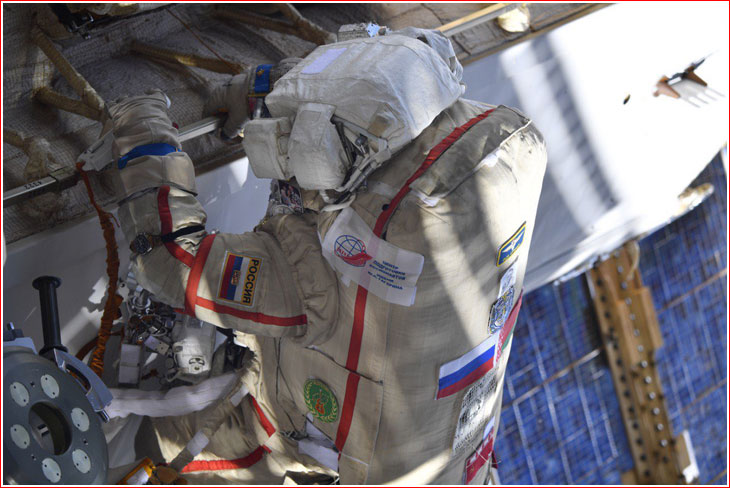
VKD-54a spacewalk at a glance:
| Spacewalk designation
|
|
| Spacewalk start |
2022 Sept. 2, 16:25 Moscow Time (actual); 16:20 Moscow Time (planned) |
| Spacewalk finish |
2022 Sept. 3, 00:13:12 Moscow Time (actual); Sept. 2, 22:38 Moscow Time (planned) |
| Spacewalk duration |
7 hours 48 minutes 11 seconds (actual); 6 hours 18 minutes (planned) |
| Spacewalker 1, EV1 |
Oleg Artemiev, EV1, Orlan-MKS No. 5 with red stripes, Cam No. 16 |
| Spacewalker 2, EV2 |
Denis Matveev, EV2, Orlan-MKS No. 4 with blue stripes, Cam No. 20 |
ISS expedition |
|
ISS spacewalk |
253rd |
| ISS in 2022 spacewalk |
8th |
| Expedition 67 EVA |
5th |
The battery failure in the Orlan spacesuit worn by Oleg Artemiev during the VKD-54 spacewalk (INSIDER CONTENT) on August 17 left unfulfilled a number of important objectives in the activation of the European Robotic Arm, ERA. Along with a few other unfinished tasks accumulated from previous spacewalks, the shortened VKD-54 prompted the addition of an extra sortie to the overall spacewalk sequence.
Within 24 hours after the completion of VKD-54, planners scheduled the add-on spacewalk for Sept. 2, 2022. It was designated VKD-54a. Aboard the station, the active preparation for the new outing started as early as August 26, according to public summaries of cosmonaut activities.
As usual, the cosmonauts were expected to exit the station via the zenith-pointing Poisk module, MIM2. The hatch opening was scheduled for 16:20 Moscow Time (9:20 a.m. EDT).
The main task of the VKD-54a was the relocation of the ERA's external control panel, EMMI, (INSIDER CONTENT) and the tests of the arm's rigidizing mechanism, TRM, designed for facilitation of payload grasping. Both of these objectives had not been met during VKD-54.
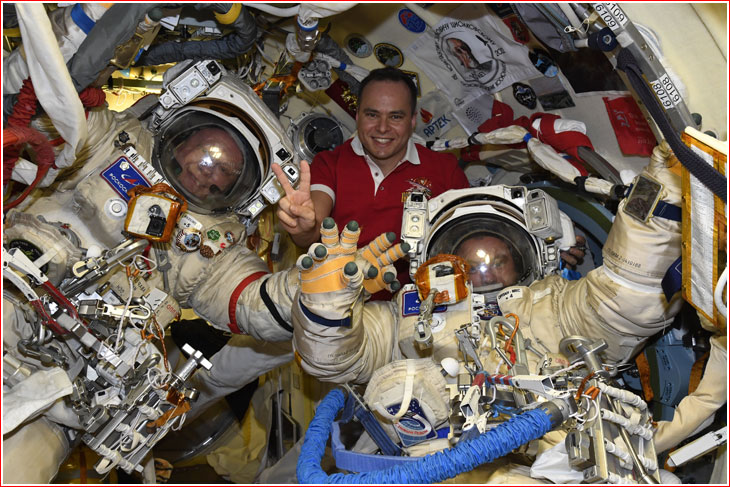
Oleg Artemiev (left), Sergei Korsakov (center) and Denis Matveev during preparations for the VKD-54a spacewalk inside the Poisk module.
For Artemiev, VKD-54A became his 8th spacewalk and for Matveev his fourth. Their colleague from the Soyuz MS-21 crew, Russian cosmonaut Sergei Korsakov was expected to be at the ERA internal control post, IMMI, inside the Nauka module, to maneuver the arm as needed during the spacewalk.
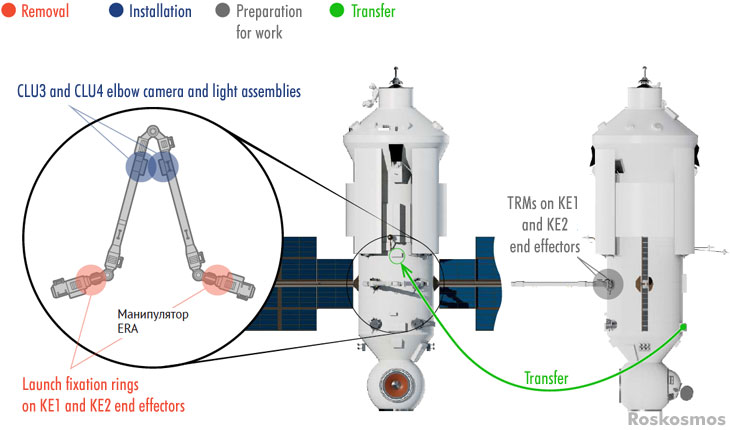
The outstanding tasks not performed during the VKD-54 included:
- Transfer to the EMMI console (attached to Handrail No. 4401), removal of EMMI;
- Transfer with EMMI to BTL3 base point, attachment of EMMI to Handrail No. 4108;
- Wiring of EMMI to the BTL3 base point;
- Testing ERA controls using the EMMI panel;
- Transfer of EMMI into the storage mode.
In addition, VKD-54 also had a number of "get-ahead" objectives for VKD-54 to be performed if time allowed:
- Replacement of protective glass on CLU1 camera at the KE1 end effector on ERA;
- Installation of a stopper on GStM1;
- Extension of GStM2 between the GA compartment of Zarya FGB and Poisk MIM2.
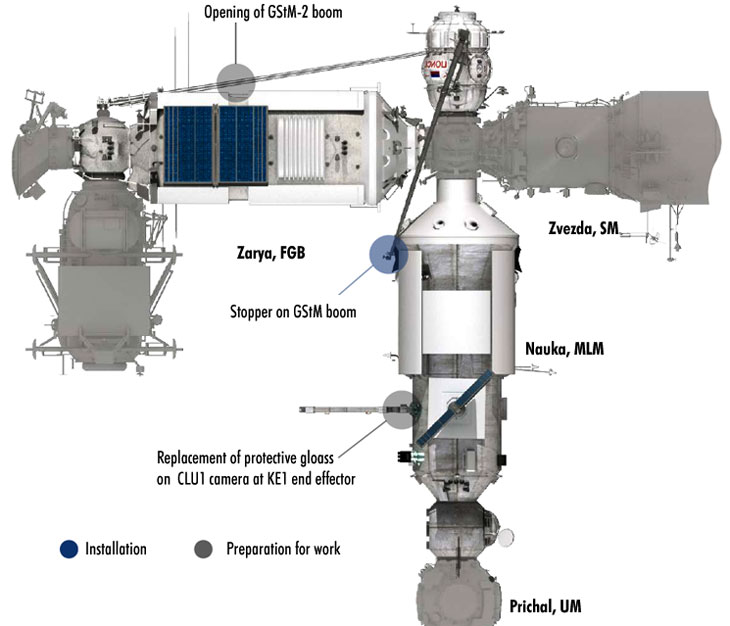
According to the Russian mission control, the VKD-54a spacewalk had the following tasks:
- The installation of a payload adapter along Plane III (Insider Content) of the Nauka module;
- Transfer of the EMMI control panel (Insider Content) to the BTL3 base point and its connection;
- Installation of two "soft" handrails along Plane I of the PGO1 section on the Nauka module;
- Adjustment of the Torque Rigidizing Mechanism, TRM, on KE2 end effector of the ERA arm;
- Adjustment of the Torque Rigidizing Mechanism, TRM, on KE1 end effector of the ERA arm;
- Removal of the launch fixation ring from the KE1 effector on ERA;
- Replacement of the protective glass cover of the camera and light unit No, 1, CLU1, on the KE1 effector of ERA;
- Testing of ERA controls using the EMMI panel;
- Installation of stopper on the Strela boom, GStM-1;
- Discarding of launch fixation rings from the ISS.
If time allows, spacewalkers had following tasks:
- Deployment of the Strela, GStM-2, boom from the Zarya FGB module to the Poisk module;
- Installation of a stopper on the GStM-2 boom.
Cosmonauts begin spacewalk
As planned on Sept. 2, 2022, Artemiev and Matveev undergone pre-breath and depressurization inside the Poisk module, MIM2. They reported completing the operations within minutes after 16:20 Moscow Time (9:20 a.m. EDT). The hatch of the Poisk module was reported opened around 16:25 Moscow Time (9:25 a.m. EDT). As usual, cosmonauts first installed a protective ring on the hatch interface, which was completed by 16:25 Moscow Time (9:30 a.m. EDT). Matveev immediately got permission from the ground to exit Poisk, as the station was approaching orbital sunrise at 16:32:49 Moscow Time (9:32 a.m. EDT). Artemiev then received a "GO" to exit Poisk at 16:39 Moscow Time (9:39 a.m. EDT) and he was seen outside within three minutes.
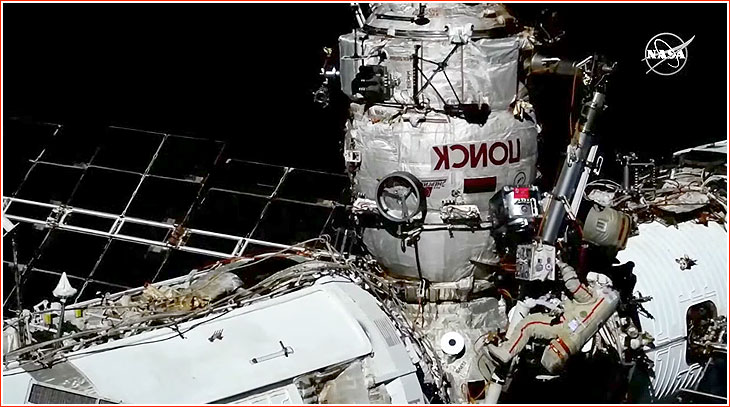
Once outside, both cosmonauts were instructed to activate their helmet cameras. At 16:45 Moscow Time (9:45 a.m. EDT), cosmonauts reported that they began transfer to a transport ring of the Strela boom with their crew lock bag and with the payload adapter platform. "We checked the tickets and took the seats, it is time for a departure," one of the cosmonauts radioed to the ground. They reached the end of the Strela boom, extending from Poisk to Nauka at 16:50 Moscow Time (9:50 a.m. EDT), and prepared for the translation to the Nauka module. The cosmonauts were given a choice to get to the work site either along Plane I or Plane III of the Nauka module.
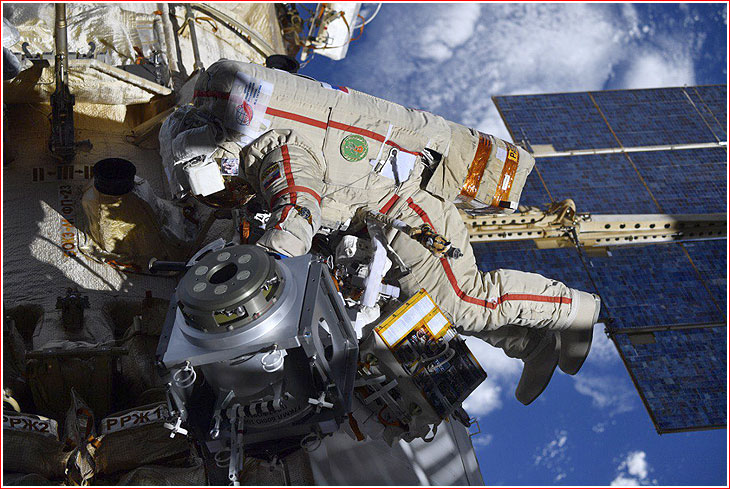
Artemiev translates along the Nauka module with the cube-shaped payload adapter on the foreground.
They apparently chose a new route, along handrails No. 4010 and 4011 on Nauka via Plane III. Cosmonauts then transferred to Handrails No. 4006 and 4007 and later moved to Handrails to 4023 and 4021.
They reached their first work site around 17:15 Moscow Time (10:15 a.m. EDT) at the BTL5 base point near Handrail 4334 and 4335. The platform was successfully latched to BTL5 at 17:18 Moscow Time (10:18 a.m. EDT), just minutes ahead of schedule.
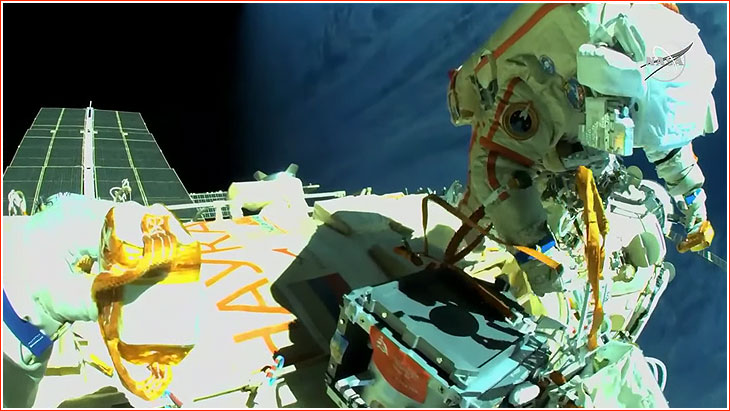
Artemiev (right) near the payload adapter emblazoned with a scaled replica of the Soviet World War II-era battle flag (bottom), soon after its installation on the BTL5 base point.
Mission control asked cosmonauts thoroughly photograph the area, because engineers did not have many images of that side of the module, while the new sunset was approaching within minutes.
Next, at 17:28 Moscow Time (10:28 a.m. EDT), cosmonauts turned to the EMMI control panel, which was attached just near by. Because the cosmonauts were also near the MDDK engine cluster (Insider Content) of the Nauka, mission control reminded them to be careful (not to contaminate their spacesuits with toxic propellant components).
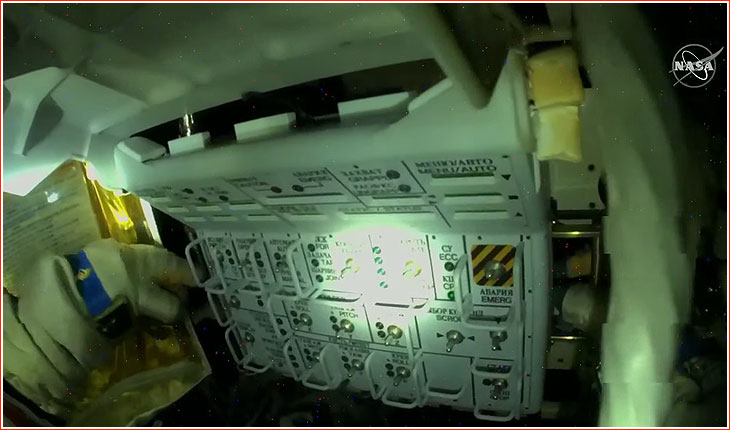
Cosmonauts opened the EMMI panel at 17:31 Moscow Time (10:31 a.m. EDT), as the station entered the sunset. (This time, the "night" period lasted from 17:31:44 Moscow Time to 18:05:43 Moscow Time.)
Mission control confirmed that the panel was on, as VKD-54 marked one hour six minutes in duration. After a short test, cosmonauts closed the panel at 17:34 Moscow Time (10:34 a.m. EDT) and prepared to move it to the new location. At 17:35 Moscow Time (10:35 a.m. EDT), mission control gave the go ahead to disconnecting the panel.
Cosmonauts reported stowing the EMMI cable at 17:38 Moscow Time (10:38 a.m. EDT). After removing the panel, the cosmonauts took a short break at 17:42 Moscow Time (10:42 a.m. EDT) and prepared to move on. They reached the UFP2 base point within a few minutes and then moved to the BTL3 base point and Handrail No. 4108, where EMMI was scheduled to be installed via a special tray adapter. EMMI was reported positioned at 17:58 Moscow Time (10:58 a.m. EDT) and, after some struggle, the cosmonauts also connected its cable to an outlet on the BTL3 base point.
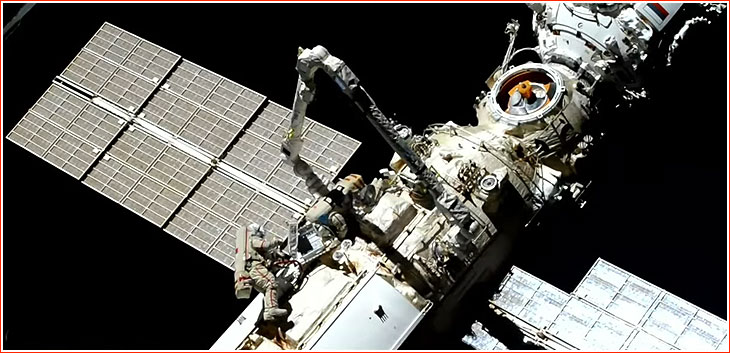
Spacewalkers re-open the EMMI control panel at its new location on Nauka's exterior.
Mission control directed cosmonauts to re-open the EMMI around 18:06 Moscow Time (11:06 a.m. EDT), as the sun rose over the horizon. Due to poor radio connection at the time, mission control asked Artemiev to switch to the installation of soft railings, while Matveev was directed to reposition cables for EMMI, making sure that the wires were at a maximum distance from ERA arm and without visible twists, which could create an entanglement risk for the arm.
At 18:09 Moscow Time (11:09 a.m. EDT), Matveev reported that one soft handrail connecting to Handrail 4108 had been installed. The cable was also confirmed in right position and mission control asked Matveev to remove one of the launch restrain rings on ERA and tie it together with a removed cover from one of the base points, so they could be later discarded as a bundle.
At 18:12 Moscow Time (11:12 a.m. EDT), the second soft rail was also reported installed.
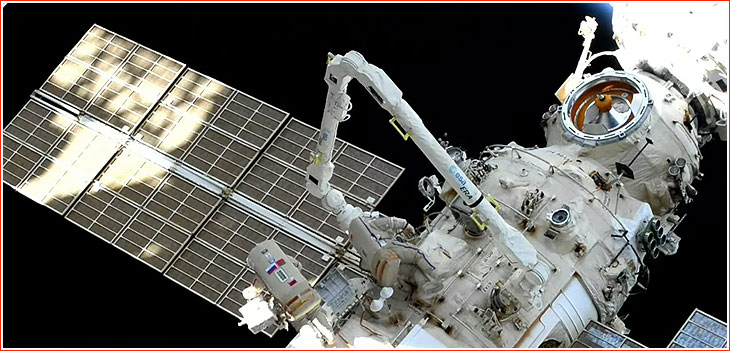
The EMMI control panel (bottom center) shortly after its installation in its new position on the Nauka module.
At 18:13 Moscow Time (11:13 a.m. EDT), EMMI was put in ON position again and Artemiev began testing its controls. He followed instructions from mission control, performing the pre-planned sequence. Artemiev reported that everything looked as planned on the console. At 18:17 Moscow Time (11:17 a.m. EDT), mission control called for a short break for the cosmonauts, while they were around half an hour ahead of schedule and mission control was waiting for the data upload into the EMMI panel.
Matveev was again reminded to attach the base point cover to the removed launch ring, so they could be discarded together.
At 18:25 Moscow Time (11:25 a.m. EDT), while still waiting for EMMI commands to execute, mission control sent cosmonauts toward the TRM indicator, located on the wrist of the ERA arm.
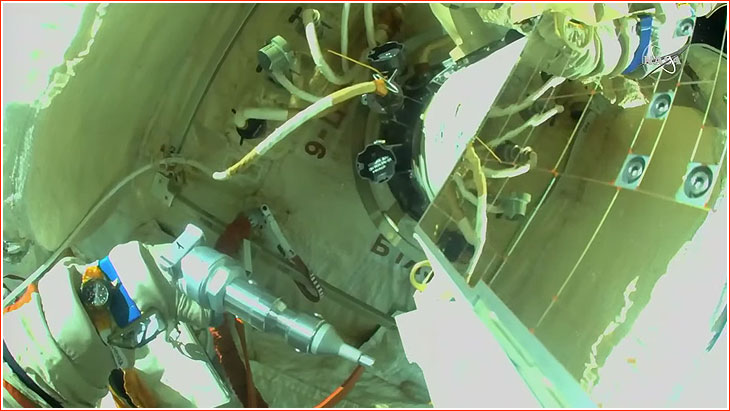
Artemiev prepares the ERA-1 tool (INSIDER CONTENT) for the adjustment of the Torque Rigidizing Mechanism, TRM.
Around 18:30 Moscow Time (11:30 a.m. EDT), Artemiev pulled out the ERA-1 wrench tool to adjust the TRM, while Matveev was asked to prepare a camera to document the procedure. Artemiev was directed to perform 19 rotations of the tool, which were completed around 18:40 Moscow Time (11:40 a.m. EDT). Mission control then confirmed that the right level for the mechanism had been reached at turn 18. After another series of adjustments, the operation was completed at 18:45 Moscow Time (11:45 a.m. EDT), around half an hour ahead of schedule.
At 18:50 Moscow Time (11:50 a.m. EDT), mission control advised Artemiev to stow the ERA-1 wrench, while waiting for the arm to switch to the "firm" position. Cosmonauts were then instructed to transfer to the KE1 end effector of the arm for another TRM adjustment. The arm's TRM indicator came to the "firm" position at 18:53 Moscow Time (11:53 a.m. EDT).
Another sunset started around 19:05 Moscow Time (12:05 p.m. EDT), as cosmonauts worked on the removal of the launch fixation ring from ERA's end effector.
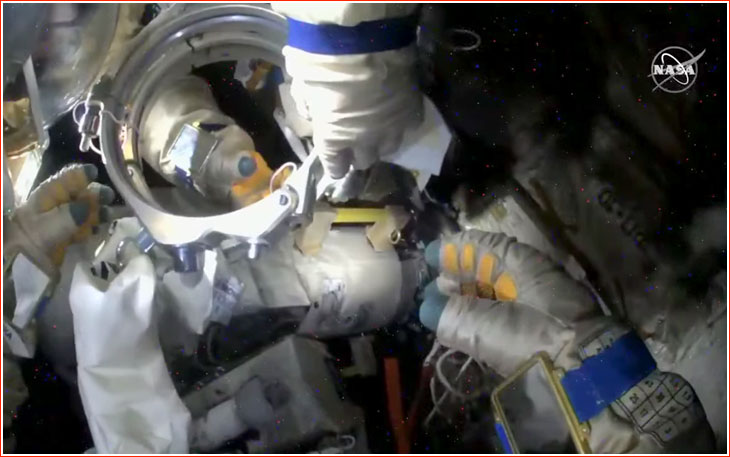
A launch fixation ring (top left) shortly after its removal from the ERA arm.
The operation was completed around 19:12 Moscow Time (12:12 p.m. EDT) and the area of the ring on the arm was covered with insulation a few minutes later. Using wire ties, cosmonauts bundled the ring together with another ring dismantled during VKD-54 (INSIDER CONTENT) and a base point cover for the subsequent release into a decay orbit.
Next, cosmonauts turned to the installation of protective windows on the CLU1 camera and light unit of the arm. After securing the protective glass, they unscrewed and removed the old glass cover. It was then placed in the crew lock bag at 19:17 Moscow Time (12:17 p.m. EDT).
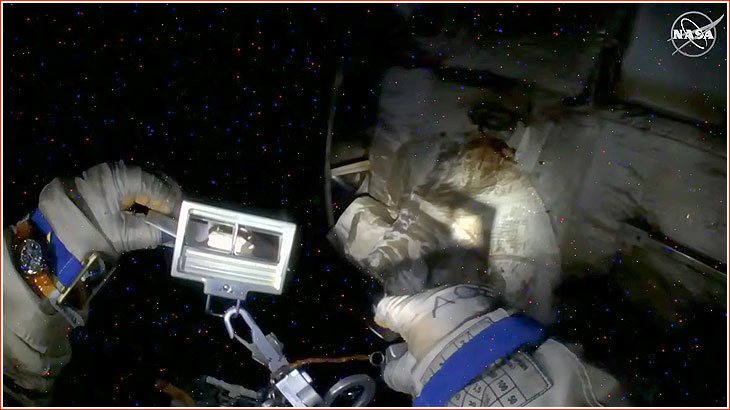
A CLU glass assembly (left) during replacement in the VKD-54.
The fresh panel was then unpacked and installed on the CLU1 assembly with the second attempt at 19:31 Moscow Time (12:31 p.m. EDT). Cosmonauts then repeated that operation successfully with the second set in the next five minutes.
Next, cosmonauts returned to the task of adjusting the TRM, around 3 hours and 13 minutes into the spacewalk. At 19:42 Moscow Time (12:42 p.m. EDT), they received the go ahead to use the ERA-1 tool (Insider Content) for 19 revolutions of the TRM mechanism, as the sun appeared over the horizon. Again, Matveev was asked to photograph the configuration of the arm.
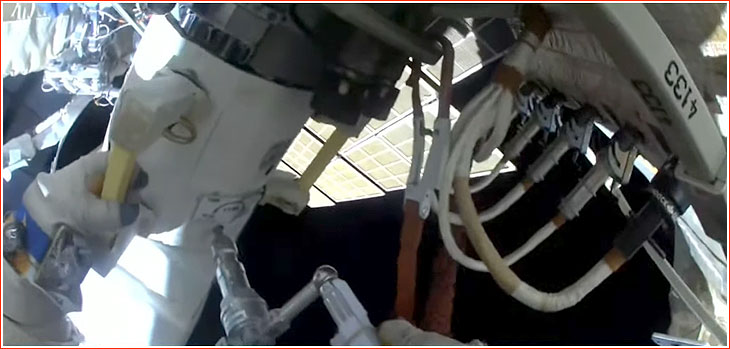
Artemiev adjusts the TRM with the ERA-1 tool (INSIDER CONTENT).
At 19:45 Moscow Time (12:45 p.m. EDT), Artemiev was told to switch the TRM to a "firm" position and rotate the tool 19 times more, without removing the tool, but it fell out in the process couple of times. This time, the firmness indicator in the window on the arm ended up in the correct middle position. The ERA-1 tool was then packed back into the crew lock bag at 19:52 Moscow Time (12:52 p.m. EDT).
At 19:55 Moscow Time (12:55 p.m. EDT), mission control instructed cosmonauts to look away from CLU, as engineers on the ground were preparing to active laser devices on the camera. Moments later, cosmonauts were asked to translate to their next places of work, while the laser activation was postponed until later time. Cosmonauts spent a few minutes in communications with mission control on their exact route and the course of action. Lasers activation warning was re-issued by ground control at 20:04 Moscow Time (1:04 p.m. EDT). By that time, cosmonauts were around one hour ahead of their official timeline, though at the price of skipping some of their built-in rest periods.
The test movement of ERA was set for 20:08 Moscow Time (1:08 p.m. EDT). At that point, Artemiev was still resting by EMMI, while Matveev moved to the Strela to work on its retainer. At 20:14 Moscow Time (1:14 p.m. EDT), another laser warning was issued, while the arm was slowly moving away from the BTL2 base point.
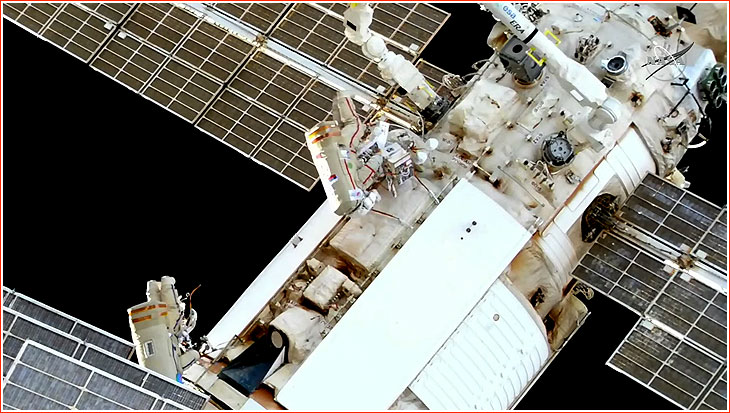
ERA undocks from its base point (right).
At 20:25 Moscow Time (1:25 p.m. EDT), cosmonauts marked four hours outside. Mission control advised the cosmonauts to save the batteries on their video cameras for the work on the Zarya FGB module. That extra task now appeared more likely to be performed during VKD-54a, thanks to the ahead-of-schedule work so far. At 20:27 Moscow Time (1:27 p.m. EDT), mission control said that the work with ERA was wrapping up and that cosmonauts could finish their video work and move to the EMMI console for another series of checks. Artemiev was cleared to start the testing routine on EMMI at 20:29 Moscow Time (1:29 p.m. EDT).
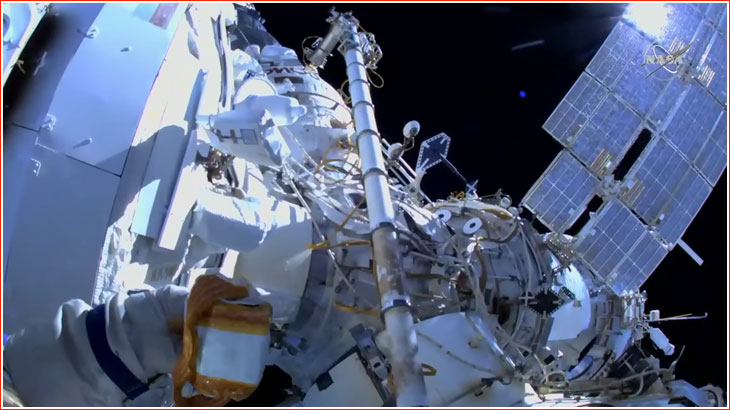
Matveev takes pictures with a hand-held camera at the end of the Strela boom.
The test was in progress as the station plunged into the earth's shadow again around 20:38 Moscow Time (1:38 p.m. EDT). That round of tests was completed at 20:44 Moscow Time (1:44 p.m. EDT), followed by another check on the ground and the switch to another check list to go over. Another ERA move was called around 20:46 Moscow Time (1:46 p.m. EDT).
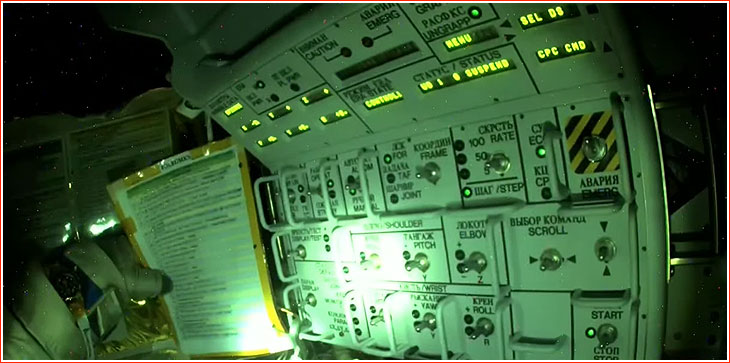
Artemiev performs EMMI tests.
At 20:53 Moscow Time (1:53 p.m. EDT), mission control told Artemiev that it was time to switch EMMI to the storage mode. He closed the cover of the console in the next two minutes.
Artemiev then returned to the issue of soft handrails. Because the newly set-up arrangement turned out to be not optimal for the transfer, mission control suggested trying to span the gap with one of the new railings between Handrails No. 4107 to 4109, instead of the originally planned location.
Also, at that point, mission control decided to proceed with secondary tasks of the VKD-54a spacewalk, because cosmonauts were well ahead of schedule.
At 21:03 Moscow Time (2:03 p.m. EDT), Artemiev was directed to the Strela, where he had a task of tightening fixators on the retainers. As Artemiev was adjusting the retainer on the Strela, the ISS emerged from the earth's shadow around 21:12 Moscow Time (2:12 p.m. EDT). A moment later, mission control informed cosmonauts that the planned release of the launch fixation rings had been cancelled after consultations on the ground due to a potential orbital debris hazard. The rings would be instead left attached to the STU docking interface of the Strela boom until the later disposal.
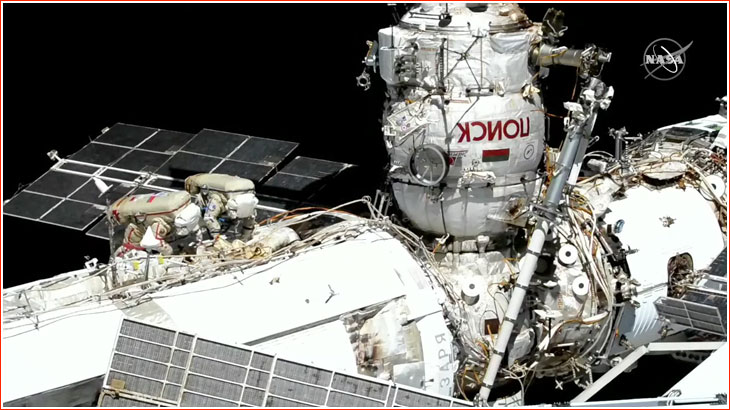
Artemiev and Matveev translate along the Zarya module.
Shortly thereafter, Artemiev and Matveev transferred to Poisk module and by 21:30 Moscow Time (2:30 p.m. EDT), both cosmonauts began their trek along the Zarya module. During that period, mission control asked Artemiev to adjust his life-support settings for better conditioning of his Orlan-MKS suit.
Spacewalkers reached the GO compartment on the Zarya module around 21:40 Moscow Time (2:40 p.m. EDT). By that time, mission control confirmed that ERA reconnected to the BTL2 base point, while the newly installed protective glass was found to be perfectly clean and transparent.
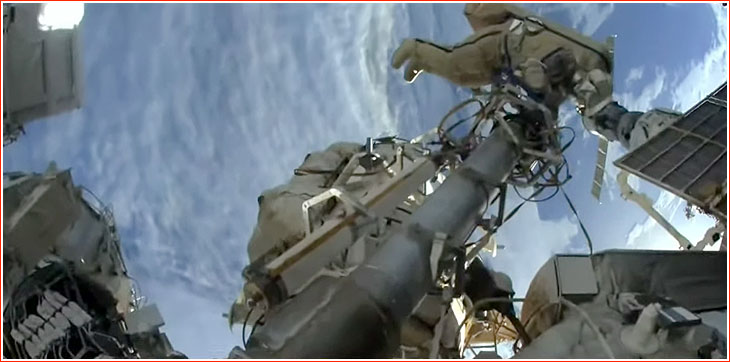
Matveev attached to the end of the Strela boom preparing for a ride from Zarya to Poisk.
At Zarya's GO compartment, Matveev configured the Strela for the deployment and at 22:01 Moscow Time (3:01 p.m. EDT), mission control gave the go ahead to the rotation of the boom along the pitch axis. Mission control warned Matveev to watch the clearance of the moving arm relative to Zarya's solar arrays.
Another period of night time started at 22:11 Moscow Time (3:11 p.m. EDT). Around 22:20 Moscow Time (3:20 p.m. EDT), Matveev bumped into difficulties rotating the control handle, while the arm was still around 30 degrees short of its target position. After some maneuvering in the darkness, the arm was finally positioned correctly around 22:35 Moscow Time (3:35 p.m. EDT). Some six hours and 10 minutes into the spacewalk, the arm was ready to swing to Poisk, but specialists on the ground asked to pause the operation for around eight minutes until daylight would provide safe conditions for the move.
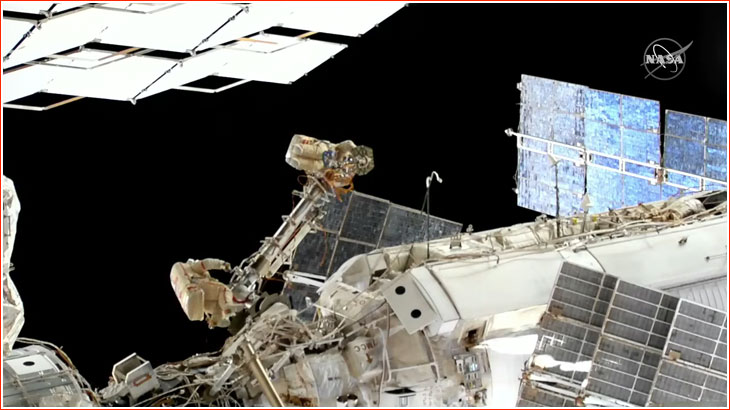
The operation was resumed at 22:45 Moscow Time (3:45 p.m. EDT), this time in the sunlight. With Matveev attached to the end of the boom, Artemiev lowered the arm roughly parallel to the Zarya's main axis. Artemiev reported that the required effort to move the arm was uneven. At 22:55 Moscow Time (3:55 p.m. EDT), ground control asked cosmonauts to begin the extension of the arm toward Poisk.
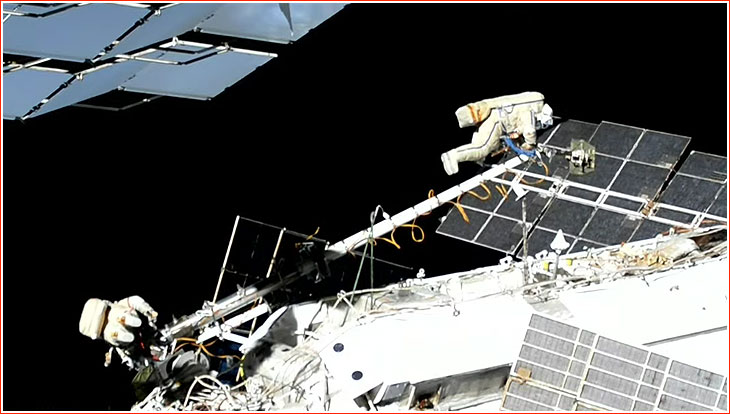
The extension process was interspersed with the pitch movement of the Strela guided by Matveev, as the cosmonauts tried to reach Poisk, while avoiding various protruding elements of Zarya below. The final pitch refinements were made between 23:02 Moscow Time (4:02 p.m. EDT) and 23:06 Moscow Time (4:06 p.m. EDT). At 23:11 Moscow Time (4:11 p.m. EDT), Strela finally reached Poisk.
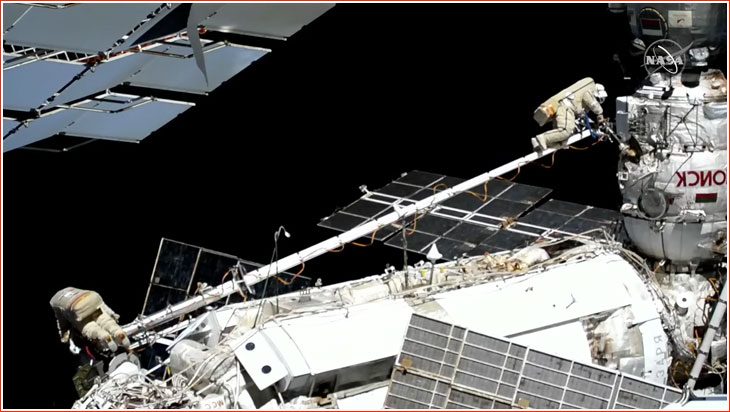
"I am trying to fix it," Matveev was heard as saying at 23:12 Moscow Time (4:12 p.m. EDT), as he secured the Strela to Handrail No. 6033 on Poisk with a safety tether.
By 23:24 Moscow Time (4:24 p.m. EDT), Artemiev quickly spanned the newly established bridge from Zarya to Poisk, where both cosmonauts performed final operations of the VKD-54a spacewalk. Mission control asked Matveev to add additional wire tie to the removed launch fixation rings to prevent their floating in space on a single security tether attached to the Strela-1 boom.
At 23:36 Moscow Time (4:36 p.m. EDT), mission control performed the final "audit" of Artemiev's equipment over the radio to confirm that all the hardware was on the way back into the airlock, while Matveev was completing fixation of the Strela boom on the opposite side from the entrance hatch of the Poisk module.
Soon after another "night" period fell at 23:44 Moscow Time (4:44 p.m. EDT), ground controllers directed cosmonauts to inspect each other's suits for contamination or damage before reentering the cramped airlock. Because of some glove contamination, cosmonauts were asked to use special towels to wipe them and then tie the used towels to handrails outside Poisk.
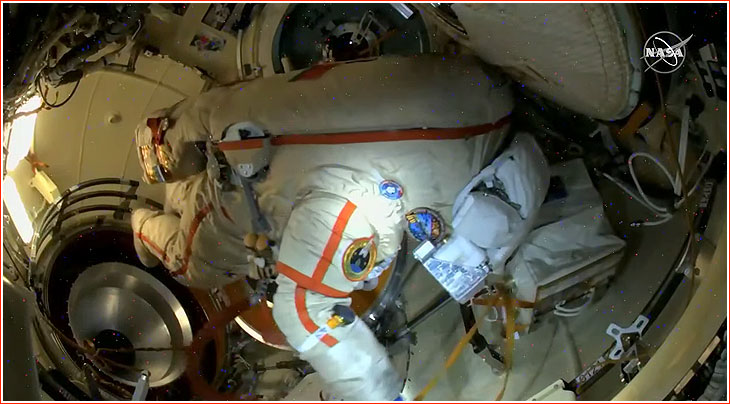
Artemiev inside the Poisk module at the conclusion of the VKD-54a spacewalk.
Artemiev was instructed to reenter Poisk at 23:53 Moscow Time (4:53 p.m. EDT) and he ingressed the module in the following two minutes. Matveev followed him inside around 23:57 Moscow Time (4:57 p.m. EDT).
After September 3 started in Moscow, cosmonauts reported the protective ring of the hatch removed around 00:08 Moscow Time, (5:08 p.m. EDT on September 2), clearing the way for the inspection of the interface and the hatch closure at 00:10 Moscow Time (5:10 p.m. EDT).
The hatch of the Poisk module was reported closed at 00:13 Moscow Time on September 3 (5:13 p.m. EDT on September 2), after 7 hours 48 minutes 11 seconds in the opened position.
Next chapter: VKD-55 spacewalk (INSIDER CONTENT)
|